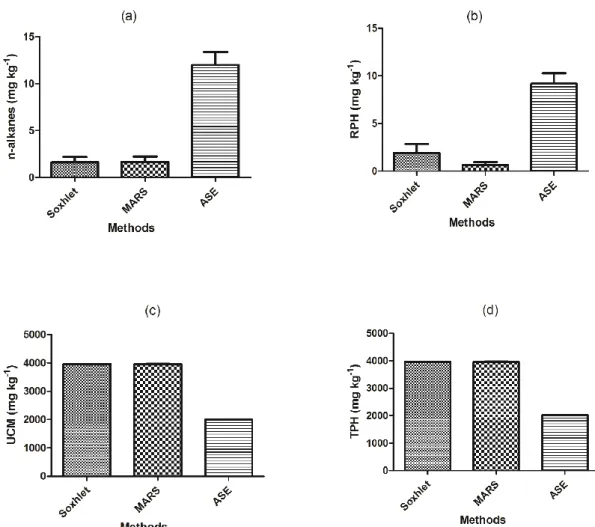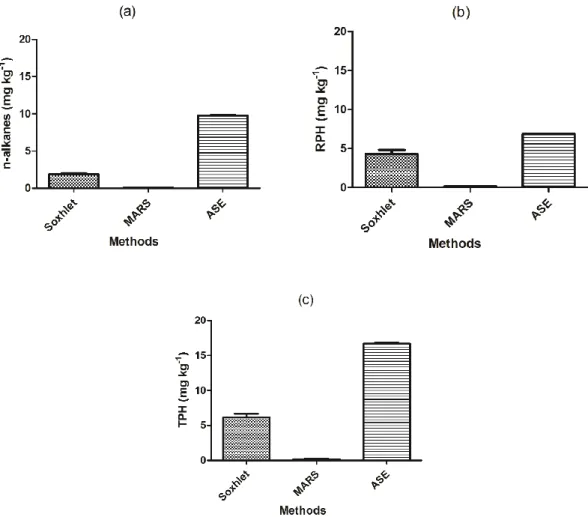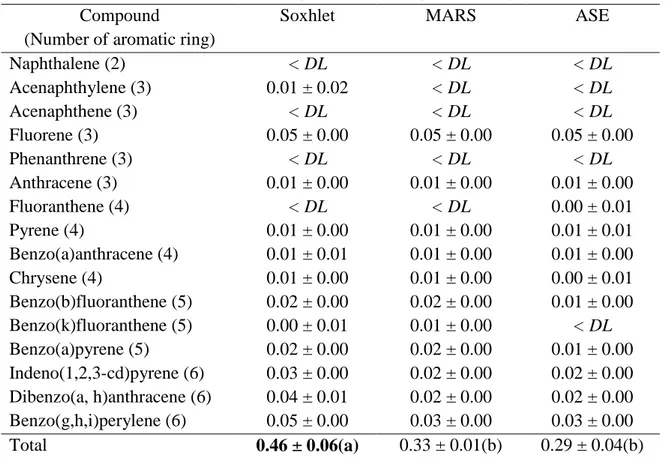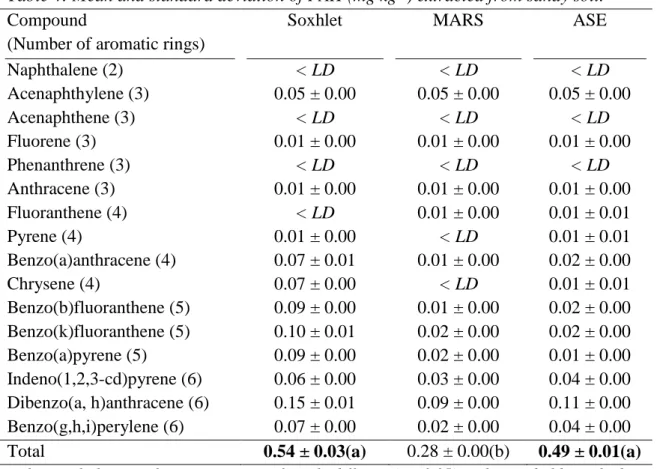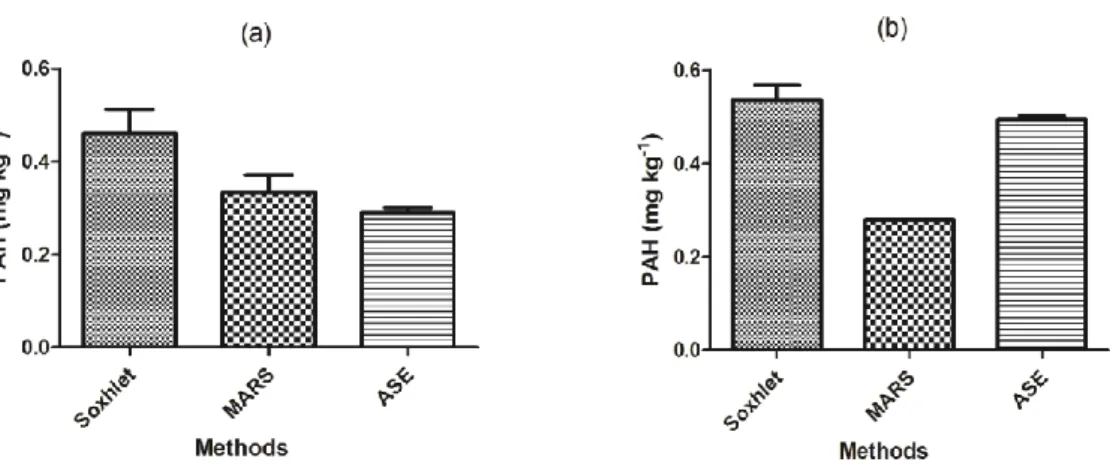Comparative study techniques for TPH and PAH
extraction from clayey and sandy soils for
chromatography analyses
Sanye Soroldoni Guimarães
1; Jorge Antonio Lopes
2;
Graciane Silva
3; Marcia Marques
1,11
Rio de Janeiro State University-UERJ, Brazil
2Petrobras Transportes - Transpetro S.A., Brazil
3Estre Ambiental, Brazil
4Linnaeus University-LNU, Sweden
ABSTRACT
The objective of this study was to compare three extraction procedures: soxhlet (SOX), microwaves (MARS) and accelerate extraction with solvent (ASE) regarding the extraction efficiency of different fractions of total petroleum hydrocarbons (TPH) and polycyclic aromatic hydrocarbons (PAH) from sandy and clayey soil with aged contamination analyzed by gas chromatography. Besides the extraction efficiency, water, solvent and time consumption were considered. Regarding clayey soil, for the extraction of different fractions of total petroleum hydrocarbons (TPH), ASE resulted in better recovery of n-alkanes and hydrocarbons resolved fraction (HRF). SOX and MARS performed better for the heaviest fraction (non-resolved complex mixture-NRCM). Regarding sandy soil, ASE performed better during extraction of all TPH fractions. In the case of polycyclic aromatic hydrocarbons (PAH), extraction with ASE showed the best result in both clayey and sandy soils. When other variables were taken into account (water, solvent and time consumption), MARS is the most economical method, particularly when TPH is the group of interest and n-alkanes is relatively less important in the analysis. Therefore, in aged contaminations, soil texture and the petroleum fraction of interest in the first place and availability of resources such as water, solvent and time in the second place must be considered before deciding what is the most appropriate extraction method.
Keywords: aged contaminated soils; extraction methods; gas chromatography, TPH;
PAH.
1 INTRODUCTION
Crude oil has compounds which, when discharged into the environment incorrectly, causes damage to health and the environment (Oga, 2008). Total petroleum hydrocarbons (TPH) is a term used to describe various compounds derived from crude oil. The determination of TPH is often used in the evaluation of areas impacted by the oil spill (Ferreira, 2010). Polycyclic aromatic hydrocarbons (PAH) compounds are characterized by having two or more aromatic rings being widely distributed in environmental compartments are considered priority pollutants since they are notoriously toxic and carcinogenic (IARC, 2000; Manzo et al, 2008; Oga, 2008). The analysis of TPH and PAH in environmental matrices usually requires extraction (depending how advanced is the GC equipment) followed by gas chromatographic separation and quantification by mass spectrometry. Different methods have been used for extraction of total petroleum hydrocarbons (TPH) and polycyclic aromatic hydrocarbons (PAHs) from the soil matrix. The efficiency of an extraction technique depends on the method of extraction, the age of the contamination, the solvent used, temperature, time and other factors. Traditionally, extracting TPH and PAH from soil is accomplished through the technique of Soxhlet method US.EPA 3540 (EPA, 1996). However, this technique requires large extraction time (6-24 h) consumes large volumes of solvent and can lead to the destruction of heat-labile compounds (Queiroz et al, 2009; Wang et al., 2007). In this sense, other extraction techniques have been largely used in order to reduce the extraction time and the solvent consumption, while maintaining the efficiency of the extraction of the compounds. Two of these techniques were studied together with soxhlet extraction: extraction assisted by microwave (MARS) and accelerated solvent extraction (ASE). The extraction technique assisted by microwave (MARS), Method 3535 US EPA (EPA, 1996) involves the use of microwave energy to produce conditions of elevated temperature and pressure in a closed vessel containing the sample and the organic solvent. Its advantages are the low use of solvent and extraction time and the possibility of multiple samples simultaneously. However, the equipment is more expensive than soxhlet system requires more accurate operator training (Wang et al. 2007). In the accelerated solvent extraction (ASE) - Method 3445, the US EPA (EPA, 1996), the solvent is heated, pressurized and passed through the sample. This method is efficient compared to Soxhlet extraction. Moreover, it requires a small amount of solvent and short extraction time. The disadvantage is once more the cost of the equipment, plus the cost for the use of nitrogen gas (Ferreira, 2010). Berset et al. (1999) argued that a good extraction technique is defined as one that removes the largest amount of the compounds of interest when, for these soils, there are no benchmarks. This study aims comparing the techniques of Soxhlet, MARS and ASE for TPH and PAH extraction from clayey and sandy soils with old contamination at relatively low concentrations, which is a relatively common scenario when decision makers shall decide if investments in remediation techniques are feasible considering the level of remaining contamination and how effective the remediation action would be. In these cases, the efficiency of the extraction technique applied is very important.
2 MATERIAL AND METHODS 2.1 Soil and chemicals used
In order to compare different extraction techniques for two different soil types (clayey and sandy soils), sampling from two different areas were collected. The first was soil with aged contamination obtained after the excavation of an old oil storage facility in operation since 1951, where the soil was ranked as clay loam. The second, was a soil from an area with aged contamination identified and quantified in a previous study (Ciannella, 2010) conducted by the research group, classified as dystrophic planosoil typical (sandy soil). The samples were kept under refrigeration and before the different extraction procedures were applied, the soil was dried in an oven and sieved (2-mm mesh).
The solvents used in the extraction processes were dichloromethane (DCM) and acetone (Tedia, pesticide grade). Anhydrous sodium sulfate (Vetec) was calcined in a muffle at 600 °C for 4 h in a desiccator and remained sealed until use. All glassware, pieces of equipment and utensils were cleaned with DCM. A mix was used for TPH with n-alkanes (C12 to C44) and another mix for 16 PAH. Another mix was used an internal standard of semi-volatile compounds (D10 acenaphthene, chrysene D12, Naphthalene D8, D12 perylene, phenanthrene and 1,4-dichlorobenzene D10 D4) all from Supelco.
2.2 Extraction procedures
The extraction procedures were made in triplicates for each soil type, extraction method and hydrocarbon group (TPH or PAH). To each sample for analysis of PAH, were added 10 µl of PAH mix. Each sample for analysis of TPH, TPH were added 10μl of mix.
2.2.1 Extraction using soxhlet
The soxhlet extraction was carried out using 5 g of the soil and 5 g of sodium sulfate. The mixture was transferred to a cellulose cartridge coupled to the extraction column. In a round bottom flask, 180 ml of DCM were poured and extraction was carried out during 16 h, at the temperature of 150 °C. After extraction, the extract was placed in a 100 ml volumetric flask placed under refrigeration until GC-MS analysis.
2.2.2 Extraction using microwave
The equipment used for extraction was the CEM MARS Xpress Microwave Reaction System (CEM Corporation). The MARS extraction was performed with 5 g of the soil sample with 5 g of sodium sulfate. The mixture was poured into a Teflon bottle where 25 ml of DCM were added to each vial before putting them in order in the carousel located inside the cavity of the microwave oven. The temperature ranged from 110 to 115 °C and pressure of 50 to 150 psi with heating time of 10 to 20 min. After extraction, cooling occurred at room temperature. The vials were opened and the extract filtered through filter paper using a piset with DCM. The extract was placed in a 100 ml volumetric flask in a refrigerated environment until the GC-MS analysis.
2.2.3 Extraction using ASE
The ASE model 350 Dionex accelerated extractor was used and for that, 5 g of the soil sample was added with 5 g of sodium sulfate. The mixture was poured into the steel flask which is part of the equipment. The extraction was carried out with a mixture of DCM and acetone (1:1) at 140 °C and 1500 psi pressure for 7 min followed by heating for 5 min static extraction. The vails were rinsed with 17 ml of the solvent mixture and the extract purged by a membrane filtration of the same brand (Dionex), using pressurized N2 at 1550 psi. The whole extraction procedure lasted approximately 30 min. After extraction, the extract was placed in a 100 ml volumetric flask and the, placed in a refrigerated environment until the GC-MS analysis.
2.3 Chromatography-mass spectrometry analysis
The chromatographic analysis of the TPH was performed on a GC/MS Agilent (model 7890A) coupled to a mass spectrometer of the same brand (model 5975C) with flame ionization detector (FID), equipped with a Agilent capillary column DB-1 MS model (30 m, 0.25 mm, 0.25 μ). The carrier gas used was Helium at a flow rate of 1 ml min-1 splitless. The injection volume was 1.0 µl and the injector temperature was 290 °C. The quantification was performed by external standardization with reference to US EPA Method 8000. The PAH were analyzed using as a reference the US EPA 8015 Method. Analyses were performed on the same chromatograph coupled to a mass spectrometer gas detector with tri-axle equipped with a capillary column DB-brand Agilent model 5MS (30 m, 0.25 mm, 0.25 μ). The carrier gas used was also the Helium with flow rate of 1 ml min-1, splitless. The injector temperature was 290 °C, the injection volume was 1.0 µl. PAHs were determined by selective ion monitoring.
2.4 Additional variables used in comparison of extraction methods
To choose the best extraction method besides (i) efficiency of the extraction and recovery of TPH and PAH, other variables were considered in this order of importance: (ii) consumption of solvent during extraction; (iii) consumption of water during extraction; (iv) time required for sample preparation and extraction. The performance classification of each extraction method regarding these three criteria were: (1) bad; (2) regular; (3) good. Additionally, the following weights were applied to each variable: (1) less relevant; (2) relevant; (3) very relevant.
2.5 Statistical analyses
One-way ANOVA followed by Tukey's comparison test was used. The program used was GrapPAHd Prism version 5.
RESULTS AND DISCUSSION
3.1. Extraction of TPH from clayey and sandy soils using Soxhlet, MARS e ASE
3.1.1 Extraction of TPH from clayey soil
Table 1 and Figure 1 show the values found for n-alkanes, resolved petroleum hydrocarbons (RPH), unresolved complex mixture (UCM) and total petroleum hydrocarbons (TPH).
Table 1: Mean and standard deviation (mg kg-1) for n-alkanes, RPH and UCM and TPH for clayey soil with aged oil contamination (N = 3).
Compound group Soxhlet MARS ASE
n- alkanes 1.58 ± 0.58(a) 1.6 ± 0.6(a) 12.4 ± 1.7(b)
RPH 1.87 ± 0.93(a) 0.7 ± 0.3(a) 8.9 ± 1.4(b)
UCM 3946.26 ± 7.31(a) 3941.9 ± 23.4(a) 1992.3 ± 17.8(b) TPH 3949.71 ± 6.64(a) 3944.2 ± 22.8(a) 2013.6 ± 17.5(b) Values with the same letter within each line are not significantly different (p> 0.05). Values in bold, best results in terms of extraction efficiency for each group of compounds.
Figure 1: Amounts of different fractions of TPH (mg kg-1) extracted by different Soxhlet, MARS and ASE from clayey soil: (a) n-alkanes; (b) resolved petroleum hydrocarbons-HRP; (c) unresolved complex mixture-UCM; (d) total petroleum hydrocarbons-TPH.
In clayey soil with oil aged contamination, the results of Soxhlet and MARS extraction in terms of amount extracted of each fraction showed no significant differences (p> 0.05) between them (Table 1), but the results were significantly different compared to those obtained with ASE (p<0.0001).
3.1.2 Extraction of TPH from sandy soil
Table 2 shows the values of n-alkanes, RPH, UCM and TPH extracted from a sandy soil with aged contamination. Figure 2 shows means and standard deviations of concentrations for TPH and fractions extracted from a sandy soil.
Table 2: Mean and standard deviation n-alkanes, HRP, MCNR and TPH for sandy soil.
Compounds Soxhlet MARS ASE
n- alkanes 1.90 ± 0.11(a) 0.10 ± 0.01(b) 9.75 ± 0.01(c)
RPH 4.30 ± 0.55(a) 0.10 ± 0.00(b) 6.80 ± 0.08(c)
UCM 0.00 ± 0.00(a) < LD(a) < LD(a)
TPH 6.15 ± 0.46(a) 0.14 ± 0.01(b) 16.70 ± 0.18(c)
Values with the same letter are not significantly different (p> 0.05). Values in bold, best results in terms of extraction efficiency for each group of compounds.
Figure 2: Amounts (mg kg-1) extracted from sandy aged contaminated soil: (a) n-alkanes; (b) RPH; (c) and UCM; (d) TPH obtained with three extraction methods (Soxhlet, MARS, ASE).
Regarding the sandy soil, all extraction techniques resulted in significant differences in the concentrations of n-alkanes, RPH and TPH (p <0.05) as shown in Table 2. However, for the UCM fraction, no difference was possible to be detected among methods, given that UCM levels were below the detection limit (DL).
Conclusion regarding TPH extraction methods for clayey and sandy soils: Extraction
by ASE showed the highest recovery of n-alkanes, for both types of soil. For the clayey soil, soxhlet and MARS (microwave) methods showed better recovery for the heavier fraction, reflected in higher recovery of UCM. These results suggest that methods that promote better extraction of heavy compounds in clay soil (soxhlet or microwave), probably lead to losses of the lightest compounds, the reason for the lower concentration of n-alkanes in the final extract obtained with soxhelt and microwave. It is well known that clayey soil has a greater capacity for adsorption of the heavier contaminants, reducing bioavailability (Smith, 2010; Mariano, 2006), making them to remain in the soil for longer periods (Kriipsalu et al., 2007).
3.2 Extraction of PAH from clayey and sandy soils using Soxhlet, MARS and ASE
3.2.1 Extraction of PAH from clay loam soil
Table 3 presents the concentrations of 16 PAHs extracted from clay loam soil.
Table 3: Mean and standard deviation of PAH extracted from the clay loam soil.
Compound
(Number of aromatic ring)
Soxhlet MARS ASE
Naphthalene (2) < DL < DL < DL Acenaphthylene (3) 0.01 ± 0.02 < DL < DL Acenaphthene (3) < DL < DL < DL Fluorene (3) 0.05 ± 0.00 0.05 ± 0.00 0.05 ± 0.00 Phenanthrene (3) < DL < DL < DL Anthracene (3) 0.01 ± 0.00 0.01 ± 0.00 0.01 ± 0.00 Fluoranthene (4) < DL < DL 0.00 ± 0.01 Pyrene (4) 0.01 ± 0.00 0.01 ± 0.00 0.01 ± 0.01 Benzo(a)anthracene (4) 0.01 ± 0.01 0.01 ± 0.00 0.01 ± 0.00 Chrysene (4) 0.01 ± 0.00 0.01 ± 0.00 0.00 ± 0.01 Benzo(b)fluoranthene (5) 0.02 ± 0.00 0.02 ± 0.00 0.01 ± 0.00 Benzo(k)fluoranthene (5) 0.00 ± 0.01 0.01 ± 0.00 < DL Benzo(a)pyrene (5) 0.02 ± 0.00 0.02 ± 0.00 0.01 ± 0.00 Indeno(1,2,3-cd)pyrene (6) 0.03 ± 0.00 0.02 ± 0.00 0.02 ± 0.00 Dibenzo(a, h)anthracene (6) 0.04 ± 0.01 0.02 ± 0.00 0.02 ± 0.00 Benzo(g,h,i)perylene (6) 0.05 ± 0.00 0.03 ± 0.00 0.03 ± 0.00 Total 0.46 ± 0.06(a) 0.33 ± 0.01(b) 0.29 ± 0.04(b)
Values with the same letter are not significantly different (p> 0.05). Values in bold are the best results in terms of extraction efficiency for the group of PAH.
Regarding PAH in clay loam soil (Table 3; Figure 3), there was no significant difference between the levels extracted by ASE and MARS (p <0.05). However, extraction by Soxhlet was significantly higher (Table 3). Since the contamination by PAH in these soils seems to be very low, the interpretation regarding extraction methods must be taken with some caution.
3.2.2 Extraction of PAH from sandy soil
Table 4 shows the values of PAH extracted from the sandy soil using Soxhlet, ASE and MARS. The contents of PAH extracted from sandy soil using Soxhlet and ASE were statistically similar (p <0.05) and significantly higher than the levels obtained with microwave (MARS) (Table 4).
Table 4: Mean and standard deviation of PAH (mg kg-1) extracted from sandy soil.
Values with the same letter are not significantly different (p> 0.05). Values in bold are the best results in terms of extraction efficiency for the group of PAH.
Figure 4 shows the levels extracted for each of the investigated techniques, both clay as sandy soil. As observed for clay loam soil, since the contamination of sandy soil by PAH was also very low, the comparison among extraction methods must be taken with some caution.
Compound
(Number of aromatic rings)
Soxhlet MARS ASE
Naphthalene (2) < LD < LD < LD Acenaphthylene (3) 0.05 ± 0.00 0.05 ± 0.00 0.05 ± 0.00 Acenaphthene (3) < LD < LD < LD Fluorene (3) 0.01 ± 0.00 0.01 ± 0.00 0.01 ± 0.00 Phenanthrene (3) < LD < LD < LD Anthracene (3) 0.01 ± 0.00 0.01 ± 0.00 0.01 ± 0.00 Fluoranthene (4) < LD 0.01 ± 0.00 0.01 ± 0.01 Pyrene (4) 0.01 ± 0.00 < LD 0.01 ± 0.01 Benzo(a)anthracene (4) 0.07 ± 0.01 0.01 ± 0.00 0.02 ± 0.00 Chrysene (4) 0.07 ± 0.00 < LD 0.01 ± 0.01 Benzo(b)fluoranthene (5) 0.09 ± 0.00 0.01 ± 0.00 0.02 ± 0.00 Benzo(k)fluoranthene (5) 0.10 ± 0.01 0.02 ± 0.00 0.02 ± 0.00 Benzo(a)pyrene (5) 0.09 ± 0.00 0.02 ± 0.00 0.01 ± 0.00 Indeno(1,2,3-cd)pyrene (6) 0.06 ± 0.00 0.03 ± 0.00 0.04 ± 0.00 Dibenzo(a, h)anthracene (6) 0.15 ± 0.01 0.09 ± 0.00 0.11 ± 0.00 Benzo(g,h,i)perylene (6) 0.07 ± 0.00 0.02 ± 0.00 0.04 ± 0.00
Figure 4: Means and standard deviations of PAH (mg kg-1) extracted from (a) clay loam soil and (b) sandy soil using Soxhlet (SOX), microwave (MARS) and accelerated solvent extraction (ASE).
3.3 Additional variables considered for the choice of extraction technique
A set of criteria and a simple scale to support decision regarding the best extraction method is presented in Table 5.
Table 5: Criteria for selecting the best extraction technique among those tested Soxhlet, ASE and MARS for TPH and PAH in aged contaminated clay loam and sandy soil.
Degree given to each criteria
Extraction capacity TPH extraction PAH extraction
Soxhlet MARS ASE Soxhlet MARS ASE
Clay loam soil n-alkanes 1 1 3
3 2 2
TPH 3 3 2
Sandy soil n-alkanes 2 1 3
3 2 3
TPH 2 1 3
Extraction capacity Clay loam soil sum 4 4 5 3 2 2
Extraction capacity Sandy soil sum 4 2 6 3 2 3
Solvent consumption c 1 3 2 1 3 2
Water consumption d 1 3 2 1 3 2
Extraction time e 1 3 2 1 3 2
Preparation time f 2 3 1 2 3 1
Global clay loam soil Global sandy soil
g=(a+c+d+e+f) 9 16 12 8 14 9
h=(b+c+d+e+f) 9 14 13 8 14 10
Value 1=bad; 2=average; 3=good.
Differences regarding variables (temperature, pressure, mode of contact with the sample, among others) make a direct comparison between the methods not possible (Wang et al., 2007). However, the recovery efficiency of the compounds of interest can be considered the most relevant one. On a second level, one can place aspects related to environmental
impact (e.g.: water and solvent consumption). On the third position, it would come variable such as time consumed and other costs.
Saim et al. (1997) considered variables such as equipment cost and effectiveness of extraction, solvent consumption and extraction time; they observed that for each variable, a different technique stood out. Using similar independent approach, the lowest cost in the present investigation was obtained with Soxhlet and those that required the shortest time to be completed were ASE and MARS.
Berset et al. (1999) pointed out that the consumption of solvent is an important criterion regarding economic and environmental costs. Wang et al. (2007) compared Soxhlet, MARS and ASE extraction techniques for PAH in soil with different organic matter contents and recent contamination and observed that ASE was the most efficient and extractions by Soxhlet and MARS were similar.
Saim et al. (1997) compared different extraction techniques (Soxhlet, MARS, ASE, supercritical fluid extraction and SFE), and they noted that for all PAH except benzo(b)fluoranthene, ASE extracted less PAH than Soxhlet.
In the present study, for extraction of PAH with 4-6 aromatic rings, Soxhlet was more effective than ASE and MARS. Not much can be said about smaller compounds (2-3 rings), since their concentration in both soils were below DL.
Berset et al. (1999), confronted the effectiveness of different methods (Soxhlet, ASE, SFE and shaker table) for extraction to PAH, however, they did not specify the type of soil, and found that ASE and SFE showed the best results compared to other methods studied considered classics.
4 CONCLUSION
The extraction of TPH and PAH from sandy and clay loam soils with oil aged contamination (over two years) using three selected methods (Soxhlet, ASE and MARS) was carried out by comparing extraction capacity for different fractions of TPH (n-alkanes, RPH, UCM) and 16 priority PAH. In addition to the comparative extraction capacity, other factors such as solvent and water consumption and time required for preparation and extraction were considered for comparison purposes. The results showed that based on the extraction capacity, the best method depends on the soil type, and the group of compounds of interest. Therefore, regarding TPH in clay loam soil, ASE showed the best extraction of n-alkanes and RPH fraction. However, for UCM fraction, Soxhlet and MARS were comparable and better than ASE. The conclusion is that ASE preserved better during the extraction process the lighter compounds.
In sandy soil, ASE was the method that presented the highest extraction for n-alkanes, RPH and UCM. Therefore, based on extraction/recovery capacity, ASE was generally superior to the other two extraction methods if TPH is the group of interest. However, when the group of interest is PAH, Soxhlet obtained the highest extraction/ recovery for clay loam and sandy soil. The results of PAH must be taken with caution due to the very low amount of these compounds in both soils investigated.
When other criteria come into the decision making process, the MARS method, followed by ASE are more environmental friendly due to much lower consumption of solvents and much shorter time for extraction, compared to Soxhlet. Still, ASE requires a longer preparation work compared with other methods. Thus, when factors such as economy of solvent, water and time are relevant, MARS is the most attractive method, particularly when the TPH is the group of interest and the n-alkanes are not relevant. Thus, in aged contamination, the soil textural class and the fraction of hydrocarbons of interest are important aspects to consider before choosing the most suitable extraction method.
ACKNOLWEDGEMENT
The authors thank FAPERJ for their support (Processes 26/102.034/2011 and E-26/103.064/2011), CNPq for the scholarship granted to the fourth author (Process 307.370/2010-0) and the company Estre Environment S/A.
REFERENCES
BERSET, J.D; EJEM, M.; HOLZER, R.; LISCHER, P. Comparison of different drying, extraction and detection techniques for the determination of priority polycyclic aromatic hydrocarbons in background contaminated soil samples, Analytica Chimica Acta, 383: 263-275, 1999.
CIANELLA, R.C. Avaliação de diferentes estratégias de biorremediação no tratamento de solo contaminado com diesel B5, Dissertação (Mestrado em Química), Universidade do Estado do Rio de Janeiro (UERJ), Rio de Janeiro, 2010;
ENVIRONMENTAL PROTECY AGENCY UNITED STATES (USEPA). Method 3540C – Soxhlet extraction, 1996.
ENVIRONMENTAL PROTECY AGENCY UNITED STATES (USEPA). Method 3545 – Pressurized fluid extraction (PFE), 1996.
ENVIRONMENTAL PROTECY AGENCY UNITED STATES (USEPA). Method 3535 – Solid-phase extraction (SPE), 1996.
FERREIRA, V.R. Otimização de protocolo analítico para extração e fracionamento de hidrocarbonetos alifáticos e aromáticos em sedimentos, Dissertação (mestrado) UFPR, Curitiba, 2010.
INTERNATIONAL AGENCY OF RESEARCH ON CANCER (IARC). IARC Monograph Volume 92 – Polycyclic Aromatic Hydrocarbons, p. 754-773, 2000. Available in: http//:monographs.iarc.fr Accessed in: 15/01/2012.
KRIIPSALU, M.; MARQUES, M.; NAMMARI, D.R.; HOGLAND, W. Bio-treatment of oily sludge: the contribution of amendment material to the content of target contaminants, and the biodegradation dynamics. Journal of Hazardous Materials, v 148, p. 616-622, 2007.
MANZO, S.; NICOLA, F.D.; PICIONE, F.D.L.; MAISTO, G.; ALFANI, A. Assessment of the effect of soil PAH accumulation by a battery of ecotoxicological tests, Chemosphere 71, 1937-1944, 2008.
MARIANO, A.P. Avaliação do potencial de biorremediação de solos e de águas subterrâneas contaminados com óleo diesel, Tese (Doutorado) Universidade Estadual Paulista (UNESP), Rio Claro, 2006.
QUEIROZ, S.C.N.; FERRACINI, V.L.; SOUZA, D.R.C.d. Métodos de extração de hidrocarbonetos policíclicos aromáticos em amostra de solo, sedimento e lodo (in Portuguese), Embrapa Meio Ambiente, 15 p., Jaguariúna, 2009.
OGA, S. Fundamentos de Toxicologia, 3ª Ed., Editora Atheneu, São Paulo, 2008. SAIM, N.; DEAN, J.R.; ABDULLAH, M.P.; ZAKARIA, Z. Extraction of polycyclic
aromatic hydrocarbons from contaminated soil using Soxhlet extraction, pressurized and atmospheric microwave-assisted extraction, supercritical fluid extraction and accelerated solvent extraction, Journal of Chromatography A, 791: 361-366, 1997. SILVA, G. Bioestímulo e bioaumento na remediação de solo contaminado com óleo
lubrificante usado – escala piloto (in Portuguese) MSc thesis (Chemical Engineering), Rio de Janeiro State University (UERJ), Rio de Janeiro, 2010.
WANG, W.; MENG, B.; LU, X.; LIU, Y.; TAO, S. Extraction of polycyclic aromatic hydrocarbons and organochlorine pesticides from soils: A comparison between Soxhlet extraction, microwave-assisted extraction and accelerated solvent extraction techniques, Analytica Chimica Acta, 602: 211-222, 2007.
